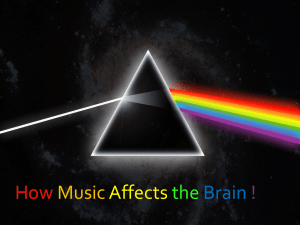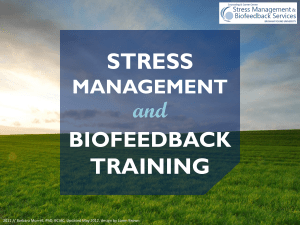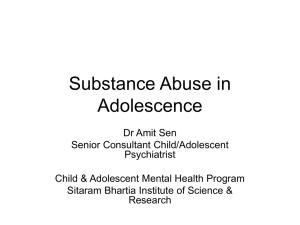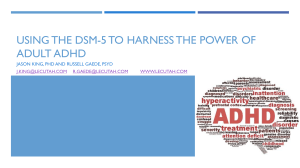A Biopsychosocial stress medicine model for ADHD: Observe
advertisement
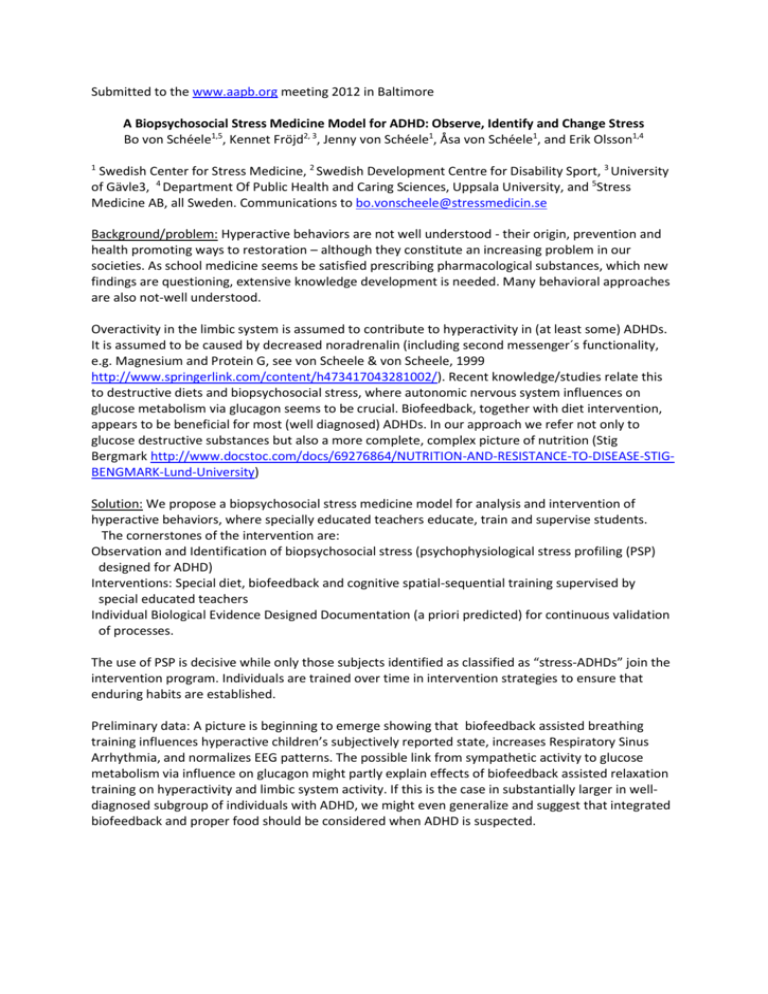
Submitted to the www.aapb.org meeting 2012 in Baltimore A Biopsychosocial Stress Medicine Model for ADHD: Observe, Identify and Change Stress Bo von Schéele1,5, Kennet Fröjd2, 3, Jenny von Schéele1, Åsa von Schéele1, and Erik Olsson1,4 1 Swedish Center for Stress Medicine, 2 Swedish Development Centre for Disability Sport, 3 University of Gävle3, 4 Department Of Public Health and Caring Sciences, Uppsala University, and 5Stress Medicine AB, all Sweden. Communications to bo.vonscheele@stressmedicin.se Background/problem: Hyperactive behaviors are not well understood - their origin, prevention and health promoting ways to restoration – although they constitute an increasing problem in our societies. As school medicine seems be satisfied prescribing pharmacological substances, which new findings are questioning, extensive knowledge development is needed. Many behavioral approaches are also not-well understood. Overactivity in the limbic system is assumed to contribute to hyperactivity in (at least some) ADHDs. It is assumed to be caused by decreased noradrenalin (including second messenger´s functionality, e.g. Magnesium and Protein G, see von Scheele & von Scheele, 1999 http://www.springerlink.com/content/h473417043281002/). Recent knowledge/studies relate this to destructive diets and biopsychosocial stress, where autonomic nervous system influences on glucose metabolism via glucagon seems to be crucial. Biofeedback, together with diet intervention, appears to be beneficial for most (well diagnosed) ADHDs. In our approach we refer not only to glucose destructive substances but also a more complete, complex picture of nutrition (Stig Bergmark http://www.docstoc.com/docs/69276864/NUTRITION-AND-RESISTANCE-TO-DISEASE-STIGBENGMARK-Lund-University) Solution: We propose a biopsychosocial stress medicine model for analysis and intervention of hyperactive behaviors, where specially educated teachers educate, train and supervise students. The cornerstones of the intervention are: Observation and Identification of biopsychosocial stress (psychophysiological stress profiling (PSP) designed for ADHD) Interventions: Special diet, biofeedback and cognitive spatial-sequential training supervised by special educated teachers Individual Biological Evidence Designed Documentation (a priori predicted) for continuous validation of processes. The use of PSP is decisive while only those subjects identified as classified as “stress-ADHDs” join the intervention program. Individuals are trained over time in intervention strategies to ensure that enduring habits are established. Preliminary data: A picture is beginning to emerge showing that biofeedback assisted breathing training influences hyperactive children’s subjectively reported state, increases Respiratory Sinus Arrhythmia, and normalizes EEG patterns. The possible link from sympathetic activity to glucose metabolism via influence on glucagon might partly explain effects of biofeedback assisted relaxation training on hyperactivity and limbic system activity. If this is the case in substantially larger in welldiagnosed subgroup of individuals with ADHD, we might even generalize and suggest that integrated biofeedback and proper food should be considered when ADHD is suspected. Longer version to be elaborated A Biopsychosocial stress medicine model for ADHD: Observe, identify and change stress Bo von Schéele1,5, Kennet Fröjd2, 3, Jenny von Schéele1, Åsa von Schéele1, and Erik Olsson1,4 1 Swedish Center for Stress Medicine, 2 Swedish Development Centre for Disability Sport, 3 University of Gävle3, 4 Department Of Public Health and Caring Sciences, Uppsala University, and 5Stress Medicine AB, all Sweden. Communications to bo.vonscheele@stressmedicin.se Background and problem: We cannot anymore just “blame” genes for complex life style related diseases and behavioral problems. We have to try to understand their causes in terms of their complex, interactions with biopsychosocial processes/factors. In empirical research we also, furthermore, need to understand this not only at nomothetic levels but also ideographically, at individual levels. Hyperactive behaviors are not well understood - its origin, prevention and health promoting ways to restoration - although it obviously constitutes an increasing problem in our societies with much suffering and costs as consequences also for individuals, families and educational systems. What is even more problematic is that traditional school medicine seems to be satisfied with the present state of unsatisfied knowledge and just, mostly, reduce observed problematic behaviors (not related dysfunctions) with pharmacological interventions, which are not well understood, but which recent knowledge development begin to identify as not only not needed but also increase of dysfunctions over time and thereby promote the development of severe diseases. In other words, new non-pharmacological based knowledge even indicates that ADHD-related pills are not at all needed for most ADHDs and its destructive effects over time can potentially be much more complicated and severe that the hyperactive behavior they are prescribed for. We cannot directly compare with using glucose as treatment of hypoglycemia but further knowledge might show that individuals´ normal hormonal, neuropeptide systems (and also specifically second messenger functions) feedback systems functioning are gradually destructive influenced. The over activity in Limbic system a as cause to ADHD is discussed as related to decrease in hormonal functioning, especially dopamine and noradrenalin, which increase is the target for amphetamine-like interventions. Increasing number of scientists and clinicians (e.g. Lendon Smith, see reference list) discuss hyper activity in terms of limbic over activity due to decreased levels of noradrenalin - and possible dopamine which in turn relates to metabolism influenced by destructive food where also biopsychosocial stress influence at many levels, e.g. autonomic nervous system balance effect on glucose metabolism via influence on glucagon. This makes biofeedback a crucial intervention strategy together with diet in hyperactive behaviors. The suggested solution: Below a biopsychosocial stress medicine model for analysis and intervention of hyperactive behaviors is presented where basic cornerstones are (i) Observation and Identification of biopsychosocial stress1 using psychophysiological stress profiling (PSP), including capacity tests and (ii) Interventions (for those with hypothesized biopsychosocial stress as main source for hyperactivity) in terms of diet, integrated biofeedback an special kind of cognitive training where a priori prediction of changes is measured using an Individual Biological Evidence Design for continuous validation of interventional processes. The approach is also called OICstress for ADHD. 1 Stress is defined as any strain put in a system that is short- or long-termed bring it out of steady state. Negative stress occurs when the system either is not brought back to steady state (if this is its biological way of functioning), e.g. continuously increased activity on sympathetic nervous system, or that dependent systems are negative influenced, as e.g. in hypocapnea when buffering systems are depleted. The use of PSP is decisive while only those subjects identified as classified as a “stress related source for their hyperactive behaviors” are suggested to the below intervention program. Intervention program: Teachers in school settings administer psychophysiological screening of ADHD children as well as teach and training them in stress medicine tools tailored use. The program and protocols are easy used and focuses on children´s relaxation capacity and train it (if it is not satisfactory) using different strategies including biofeedback. The protocol contents single case prepost design, different relaxation approaches, different biofeedback approaches which transmit data to a data base where an artificial intelligence program analyze data and provide users with a report, where also suggestions for measures are given. Moreover, included is also (i) gradually changing negative food habits, (ii) exercise, and (iii) cognitive-behavioral ways to cope with very day life situations as well as (iv) a specific problem solving strategy. Included in the cStress4ADHD is furthermore educational program for teachers as well as a “patient-educational” program. Important is that suggested strategies are used over a long period of time ensuring habits are established. Before frequent used of the approach above more data in terms of a priori predicted individual biological evidence as well as nomothetical studies is needed. Case data below is discussed below, illustrating the changes in autonomic nervous systems during neurofeedback where main changes relates to breathing behaviors Above is shown data from base line I 14 year old ADHD (complex problems). The red line is heart rate (HR). And compare HR below in neurofeedback training - Alpha-theta neurofeedback activities. Not much changes. Above is only breathing phasing 7 breath pe minute given. Theta is decreased. The subject feels very good. Above is flexibility in Respiratory Sinus arrhythmia (RSA) tested. As can be shown RSA is flexible, which is important information. The subject has now done 10 sessions with pronounced success. Breathing training was main strategy while EEG was recording. Summarizing; A picture is beginning to emerge which shows that hyperactive children´s biofeedback assisted breathing training influence their subjective reported state, increase Respiratory Sinus Arrhythmia (and other traditional psychophysiological measures), as well as decrease Theta waves. The possible link from sympathetic activity to glucose metabolism via influence on glucagon might partly explained effects of biofeedback assisted relaxation training on hyperactivity and over activity of Limbic system. If this might be the case in a substantially large group of ADHD, we can generalize and I suggest that integrated biofeedback and proper food always can be considered when ADHD is suspected. With proper food we not only refer to glucose destructive substances but also a more complete constructive nutrition approach (Stig Bergmark, see reference list) In sum, data indicate stress physiological dysfunctions which is assumed to be normalize by stress medicine interventional education and training – in school settings The complete system contents; (i) Hard ware, (ii) cStress soft ware, (iii) cStress ADHD protocols, (iv) AI program for analysis and reports, (v) Educational programs and (vi) cStress data base system References Bergmark, Stig; http://www.docstoc.com/docs/69276864/NUTRITION-AND-RESISTANCE-TO-DISEASESTIG-BENGMARK-Lund-University S. Himani Kariyawasam, Frank Zaw, Sheila L. Handley: Reduced Salivary Cortisol in Children with Comorbid Attention Deficit Hyperactivity Disorder and Oppositional Defiant Disorder. Lidy M.J. Pelsser, Klaas Frankena, Jan Toorman, Huub F.J. Savelkoul, Rob Rodrigues Pereira & Jan K. Buitelaar: A randomised controlled trial into the effects of food on ADHD. Eur Child Adolesc Psychiatry (2009) 18:12–19 DOI 10.1007/s00787-008-0695-7. Lendon Smith: http://www.phosadd.com/support%20evidence/lsmith.htm von Schéele, B.H.C. & von Schéele I.A.M.(1999). The Measurement of Respiratory and Metabolic Parameters of Patients and Controls Be¬fore and After Incremental Exercise on Bicycle: Supporting the Effort Syndrome Hypothesis? Applied Psychophysiology and Biofeedback, Vol. 24, No 3. 167-177 A Biopsychosocial stress medicine model for ADHD: Observe, identify and change stress Bo von Schéele, Ph D, Professor, Swedish Center for Stress medicine, Sweden Background/problem: Hyperactive behaviors are not well understood - their origin, prevention and health promoting ways to restoration – although they constitute am increasing problem in our societies. As school medicine seems be satisfied prescribing pharmacological substances, new behavioral approaches are questioned or not-well understood.. Overactivity in the limbic system is assumed to be caused by decreased noradrenalin, second messengers. and and protein G(von Scheele & von Scheele, 1999 http://www.springerlink.com/content/h473417043281002/) Recent knowledge relates this to a destructive diet and biopsychosocial stress, where autonomic nervous system influence on glucagon interferes with glucose metabolism. Biofeedback together with diet intervention appear to be beneficial for ADHD. In our approach we refer not only to glucose destructive substances but also a more complete picture of nutrition (Stig Bergmark http://www.docstoc.com/docs/69276864/NUTRITION-AND-RESISTANCE-TO-DISEASE-STIGBENGMARK-Lund-University) We propose a biopsychosocial stress medicine model for analysis and intervention of hyperactive behaviors, where specially educated teachers supervise students. The cornerstones of the intervention are: Observation and Identification of biopsychosocial stress (psychophysiological stress profiling designed for ADHD) Interventions: special diet, biofeedback and cognitive spatial-sequential training An individual Biological Evidence Design for continuous validation of processes. The use of PSP is decisive while only those subjects identified as classified as a “stress-ADHD” join the intervention program. Individuals are trained over time in intervention strategiesto ensure that enduring habits are established. Preliminary data: A picture is beginning to emerge showing that biofeedback assisted breathing training influences hyperactive children’s subjectively reported state, increases Respiratory Sinus Arrhythmia, and normalizes EEG patterns. The possible link from sympathetic activity to glucose metabolism via influence on glucagon might partly explain effects of biofeedback assisted relaxation training on hyperactivity and limbic system activity. If this is the case in a substantially larger subgroup of individuals with ADHD, we can generalize and suggest that integrated biofeedback and proper food should be considered when ADHD is suspected. Titel + abstract 350 words + authors A Biopsychosocial stress medicine model for ADHD: Observe, identify and Change stress - OICstress Bo von Schéele, Ph D, Professor, Swedish Center for Stress medicine, Sweden Background/problem: We cannot anymore just “blame” genes for complex life style related diseases and behavioral problems. Hyperactive behaviors are not well understood - its origin, prevention and health promoting ways to restoration - although constitutes increasing problem in our societies. As school medicine seems be satisfied with present state while prescribing pharmacological substances, which new findings questioned or not-well understood behavioral approaches. Where overactivity in Limbic system as assumed and cause by decreased noradrenalin (and second messenger and protein G, von Scheele & von Scheele, 1999 http://www.springerlink.com/content/h473417043281002/) recent knowledge relate this to destructive diet and biopsychosocial stress where autonomic nervous system influence on glucagon harass glucose metabolism motivating also here biofeedback as crucial intervention together with diet for ADHD. Solution: We propose a biopsychosocial stress medicine model for analysis and intervention of hyperactive behaviors is presented where special educated teachers are supervising students. Basic cornerstones are Observation and Identification of biopsychosocial stress (psychophysiological stress profiling design for ADHD) Interventions; special diet, biofeedback and cognitive spatial-sequential training Individual Biological Evidence Design for continuous validation of processes. The use of PSP is decisive while only those subjects identified as classified as a “stress-ADHD” join the intervention program. Important is that trained strategies are used over time ensuring habits are established. Preliminary data indicates; a picture is beginning to emerge which shows that hyperactive children´s biofeedback assisted breathing training influence their subjective reported state, increase Respiratory Sinus Arrhythmia including its pattern (and other traditional psychophysiological measures), as well as normalizing EEG patterns. The possible link from sympathetic activity to glucose metabolism via influence on glucagon might partly explained effects of biofeedback assisted relaxation training on hyperactivity and over activity of Limbic system. If this might be the case in a substantially larger subgroup of ADHD, we can generalize and suggest that integrated biofeedback and proper food should be considered when ADHD is suspected. First it can be done during a test period and then, if a priori predicted results implemented. With proper food we not only refer to glucose destructive substances but also a more complete constructive nutrition approach (Stig Bergmark http://www.docstoc.com/docs/69276864/NUTRITION-AND-RESISTANCE-TO-DISEASE-STIGBENGMARK-Lund-University) Case data in very complex 14-years ADHD illustrates pronounced effects of biofeedback assisted breathing training. Intervention program: Teachers in school settings administer psychophysiological screening of ADHD children as well as teach and training them in stress medicine tools tailored use. The program and protocols are easy used and focuses on children´s relaxation capacity and train it (if it is not satisfactory) using different strategies including biofeedback. The protocol contents single case prepost design, different relaxation approaches, different biofeedback approaches which transmit data to a data base where an artificial intelligence program analyze data and provide users with a report, where also suggestions for measures are given. Moreover, included is also (i) gradually changing negative food habits, (ii) exercise, and (iii) cognitive-behavioral ways to cope with very day life situations as well as (iv) a specific problem solving strategy. Included in the cStress4ADHD is furthermore educational program for teachers as well as a “patient-educational” program. Important is that suggested strategies are used over a long period of time ensuring habits are established. Before frequent used of the approach above more data in terms of a priori predicted individual biological evidence as well as nomothetical studies is needed. Case data below is discussed below, illustrating the changes in autonomic nervous systems during neurofeedback where main changes relates to breathing behaviors Above is shown data from base line I 14 year old ADHD (complex problems). The red line is heart rate (HR). And compare HR below in neurofeedback training - Alpha-theta neurofeedback activities. Not much changes. Above is only breathing phasing 7 breath pe minute given. Theta is decreased. The subject feels very good. Above is flexibility in Respiratory Sinus arrhythmia (RSA) tested. As can be shown RSA is flexible, which is an important information. The subject has now done 10 sessions with pronounced success. Breathing training was main strategy while EEG was recording. Summarizing; A picture is beginning to emerge which shows that hyperactive children´s biofeedback assisted breathing training influence their subjective reported state, increase Respiratory Sinus Arrhythmia (and other traditional psychophysiological measures), as well as decrease Theta waves. The possible link from sympathetic activity to glucose metabolism via influence on glucagon might partly explained effects of biofeedback assisted relaxation training on hyperactivity and over activity of Limbic system. If this might be the case in a substantially large group of ADHD, we an generalize and i suggest that integrated biofeedback and proper food always can be considered when ADHD is suspected. With proper food we not only refer to glucose destructive substances but also a more complete constructive nutrition approach (Bergmark, see reference list) In sum, data indicate stress physiological dysfunctions which is assumed to be normalize by stress medicine interventional education and training – in school settings The complete system contents; (i) Hard ware, (ii) cStress soft ware, (iii) cStress ADHD protocols, (iv) AI program for analysis and reports, (v) Educational programs and (vi) cStress data base system References Bergmark, Stig; http://www.docstoc.com/docs/69276864/NUTRITION-AND-RESISTANCE-TO-DISEASESTIG-BENGMARK-Lund-University S. Himani Kariyawasam, Frank Zaw, Sheila L. Handley: Reduced Salivary Cortisol in Children with Comorbid Attention Deficit Hyperactivity Disorder and Oppositional Defiant Disorder. Lidy M.J. Pelsser, Klaas Frankena, Jan Toorman, Huub F.J. Savelkoul, Rob Rodrigues Pereira & Jan K. Buitelaar: A randomised controlled trial into the effects of food on ADHD. Eur Child Adolesc Psychiatry (2009) 18:12–19 DOI 10.1007/s00787-0080695-7. Lendon Smith: http://www.phosadd.com/support%20evidence/lsmith.htm Von Schéele, Bo H. C. & von Schéele, Ingrid, A.M (1999) ……. Texts not used – “storage” In summary, we argue, hyperactive behaviors relate to (i) Imbalance in autonomic nervous system, especially increase in sympathetic activities which in turn influence glucagon during hypoglycemia state – that is, biofeedback assisted normalization of ANS as used in many biopsychosocial stress related diseases as well as it influence on basic metabolism, motivate psychophysiological assessment and interventions (ii) Destructive food has a number of negative effects on hyperactivity, e.g. hypoglycemia and changes in B-vitamins and low magnesium. The latter and Protein G (von Schéele 6 von Schéele, 1999) is influencing hormonal second messenger functioning, which is disturbing the functioning of hormonal signal to mitochondria – interfering with its feedback systems functioning. Those proper diet need to be a part of a treatment package for hyperactivity. Case 14 years boy; Below is psychophysiological shown during neurofeedback session from one case discussed. As there is a clear a priori prediction about stress physiological reason for this subject´s problems data encourage further psychophysiological data collection of ADHD children 1 = base line 3 minutes and then 30 seconds with close and eyes open twice (3´+30+30+30 2 = Alpha-theta neurofeedback activities where respiration is phased (7 breathe per minute – reason is ….) 3 = Beta neurofeedback training 4 = Testing heart rate flexibility related to changes in breathing frequency Psychophysiological data show; Low finger temperature indicating influence of sympathetic activity and also possibly effect of too much sugar and soft drinks just before. Skin conductance somewhat high as well as pronounced fluctuation Heart rate – pronounced variation difference between relaxed breathing and habitual breathing behaviors. This indicate a pronounced effect on the autonomic oscillation during relaxed breathing which indicate that breathing training independent of neuro- or biofeedback or bodily feedback probably is very important. Oxygen saturation indicates compensation which needs to be further analyzed, especially as an acidosis is indicated (below). Exhalation Carbone oxide indicate an acidosis (which is further complicated by the observed oxygen compensation). Pharmacological interventions can be the cause of the acidosis.



